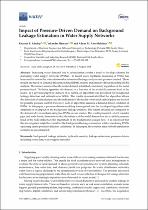 ResearchSpace
ResearchSpace
Impact of pressure-driven demand on background leakage estimation in water supply networks
JavaScript is disabled for your browser. Some features of this site may not work without it.
- ResearchSpace
- →
- Research Publications/Outputs
- →
- Journal Articles
- →
- View Item
| dc.contributor.author |
Adedeji, KB

|
|
| dc.contributor.author |
Hamam, Y

|
|
| dc.contributor.author |
Abu-Mahfouz, Adnan MI

|
|
| dc.date.accessioned | 2019-10-17T08:48:34Z | |
| dc.date.available | 2019-10-17T08:48:34Z | |
| dc.date.issued | 2019 | |
| dc.identifier.citation | Adedeji, K.B., Hamam, Y. & Abu-Mahfouz, A.M.I. 2019. Impact of pressure-driven demand on background leakage estimation in water supply networks. Water, pp., 12pp | en_US |
| dc.identifier.issn | 2073-4441 | |
| dc.identifier.uri | https://www.mdpi.com/2073-4441/11/8/1600 | |
| dc.identifier.uri | https://doi.org/10.3390/w11081600 | |
| dc.identifier.uri | http://hdl.handle.net/10204/11175 | |
| dc.description | Copyright: 2019 by the authors. Licensee MDPI, Basel, Switzerland. This is an open access article distributed under the Creative Commons Attribution License which permits unrestricted use, distribution, and reproduction in any medium, provided the original work is properly cited. | en_US |
| dc.description.abstract | Increasing water demand due to urbanization creates a need to develop schemes for managing water supply networks (WSNs). In recent years, hydraulic modeling of WSNs has been used to assess the state of networks in terms of leakage analysis and pressure control. These models are based on demand-driven modeling (DDM) analysis and pressure-driven modeling (PDM) analysis. The former assumes that the nodal demand is fulfilled consistently regardless of the nodal pressure head. The latter appraises the demand as a function of the available pressure head at the nodes. In a previous paper by Adedeji et al. (2017), an algorithm was presented for background leakage detection and estimation in WSNs. The results demonstrated that the algorithm allows the detection of critical pipes and the indication of the nodes where such critical pipes are located for possible pressure control. However, such an algorithm assumes a demand-driven condition of WSNs. In this paper, a pressure-driven modeling is integrated into the developed algorithm with emphasis on its impact on the background leakage estimate. The results obtained are compared to the demand-driven analysis using two WSNs as case studies. The results presented, which consider pipe and node levels, demonstrate that the reliance of the nodal demand on the available pressure head at the node influences the magnitude of the background leakage flow. It is conceived that this investigation might be crucial for the background leakage estimation while considering WSNs operating under pressure-deficient conditions. In this paper, the solution time for both simulation scenarios is also presented. | en_US |
| dc.language.iso | en | en_US |
| dc.relation.ispartofseries | Workflow;22752 | |
| dc.subject | Water demands | en_US |
| dc.subject | Water supply networks | en_US |
| dc.subject | WSNs | en_US |
| dc.subject | Water leakages | en_US |
| dc.title | Impact of pressure-driven demand on background leakage estimation in water supply networks | en_US |
| dc.type | Article | en_US |
| dc.identifier.apacitation | Adedeji, K., Hamam, Y., & Abu-Mahfouz, A. M. (2019). Impact of pressure-driven demand on background leakage estimation in water supply networks. http://hdl.handle.net/10204/11175 | en_ZA |
| dc.identifier.chicagocitation | Adedeji, KB, Y Hamam, and Adnan MI Abu-Mahfouz "Impact of pressure-driven demand on background leakage estimation in water supply networks." (2019) http://hdl.handle.net/10204/11175 | en_ZA |
| dc.identifier.vancouvercitation | Adedeji K, Hamam Y, Abu-Mahfouz AM. Impact of pressure-driven demand on background leakage estimation in water supply networks. 2019; http://hdl.handle.net/10204/11175. | en_ZA |
| dc.identifier.ris | TY - Article AU - Adedeji, KB AU - Hamam, Y AU - Abu-Mahfouz, Adnan MI AB - Increasing water demand due to urbanization creates a need to develop schemes for managing water supply networks (WSNs). In recent years, hydraulic modeling of WSNs has been used to assess the state of networks in terms of leakage analysis and pressure control. These models are based on demand-driven modeling (DDM) analysis and pressure-driven modeling (PDM) analysis. The former assumes that the nodal demand is fulfilled consistently regardless of the nodal pressure head. The latter appraises the demand as a function of the available pressure head at the nodes. In a previous paper by Adedeji et al. (2017), an algorithm was presented for background leakage detection and estimation in WSNs. The results demonstrated that the algorithm allows the detection of critical pipes and the indication of the nodes where such critical pipes are located for possible pressure control. However, such an algorithm assumes a demand-driven condition of WSNs. In this paper, a pressure-driven modeling is integrated into the developed algorithm with emphasis on its impact on the background leakage estimate. The results obtained are compared to the demand-driven analysis using two WSNs as case studies. The results presented, which consider pipe and node levels, demonstrate that the reliance of the nodal demand on the available pressure head at the node influences the magnitude of the background leakage flow. It is conceived that this investigation might be crucial for the background leakage estimation while considering WSNs operating under pressure-deficient conditions. In this paper, the solution time for both simulation scenarios is also presented. DA - 2019 DB - ResearchSpace DP - CSIR KW - Water demands KW - Water supply networks KW - WSNs KW - Water leakages LK - https://researchspace.csir.co.za PY - 2019 SM - 2073-4441 T1 - Impact of pressure-driven demand on background leakage estimation in water supply networks TI - Impact of pressure-driven demand on background leakage estimation in water supply networks UR - http://hdl.handle.net/10204/11175 ER - | en_ZA |





